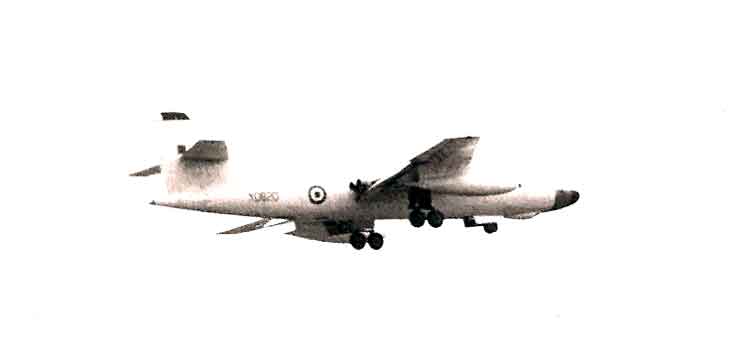
|
||
|
Flypast of Vickers Valiant, (see below), for Anglo-German Open Day flying display on 6Jun59. (Thanks to Bill Webb.) Vickers Valiant B.Mk.1 Designed to meet the requirements of Specification B.9/48, the Vickers Valiant was the first of the RAF's trio of 'V-Bombers', and played a vital part in building up Britain's strategic nuclear deterrent. The first Vickers Type 660 Valiant flew on 18 May 1951 and production Valiant B.Mk1s were delivered to No. 232 OCU at Gaydon, Warwickshire, in January 1955. The Valiant subsequently armed Nos. 7, 18 (ECM), 49, 90, 138, 148, 199, 207, 214 and 543 Squadrons, the latter being equipped with the B.(PR)1 strategic reconnaissance variant. No. 138 Squadron was the first to equip with the type, and No. 49 Squadron was the nuclear weapons trials unit, its aircraft participating in nuclear weapons tests in Australia (1956) and Christmas Island (1957-58). Valiants saw action in the Anglo-French Suez operation pf October-November 1956, attacking Egyptian airfields with conventional bombs. In 1963 the Valiant force was assigned to SACEUR in the tactical bombing role; however, it was withdrawn prematurely because of fatigue cracks in the main spar. The Valiant BK.1 was a flight refuelling tanker conversion, and the Valiant B.Mk.II was a one-off prototype stressed for low-level, high-speed penetration. Valiant production amounted to 108 aircraft, plus two prototypes and the solitary B.Mk.II. Of this total, 14 were B.(PR)K.1s and 45 were BK.1s, most of them conversions. During their career, Valiants made several notable long-distance flights. In October 1953 the second prototype aircraft, WB215, took part in the London-New Zealand air race, being specially fitted with underwing fuel tanks. On 9 July 1959 a Valiant of No. 214 Squadron made the first non-stop flight from the United Kingdom to Cape Town in South Africa, being refuelled in the air twice, and on 2-3 March 1960 a Valiant of the same unit made the longest nonstop flight by an RAF aircraft up to that time, 13,676 Km (8,500 miles) around the United Kingdom. In May that year another 214 Squadron aircraft flew nonstop from the United Kingdom to Singapore. The Valiant tended to be over-shadowed by the RAF's later V-bombers, the Vulcan and Victor, however, the contribution that it made to the development of the Bomber Command's nuclear alert force was immeasurably important. Not only did it pioneer the introduction of free-fall nuclear weapons into operational service, but it also acted as trials aircraft for the Avro Blue Steel stand-off bomb, the weapon that would have given the V-bombers a chance of survival in the 1960s. In addition, the Valiant pioneered the techniques that would have ensured the V-force's viability in the event of a war alert; dispersal techniques, overseas deployments and so on. And, if the Air Staff had seen fit to develop the strengthened low-level version, it is likely that the Valiant would have continued to be a viable weapons system for many years. Specifications apply to the Vickers Valiant B.Mk1. Crew: 5; Powerplant: four 4,559 Kg (10,050 lb) Rolls-Royce Avon 204 turbojet engines; Performance: max speed 912 Km/h (567 mph); range 7,424 Km (4,500 miles) service ceiling 16,460 m (54,000 ft) Dimensions: wingspan 34.85 m(114 ft 4 in); length 33.00 m (108 ft 3 in); height 9.802 m (32 ft 2 in). Weight: 79,378 Kg (175,000 lb) loaded. Armament: one 4,530 Kg (10,000 lb) MC Mk.1 Blue Danube nuclear bomb; four 906 Kg (2,000 lb) Red Beard tactical nuclear bombs; one 2,721 Kg (6,000 lb) Mk.5 (US) nuclear bomb; four Mk.28 or Mk.43 (US) thermonuclear bombs; or 21 x 453 Kg ( 1,000 lb) conventional bombs.(Thanks to The Encyclopedia of Aircraft edited by Robert Jackson). |
||